Six delicious recipes from Rosheen Kaul's cookbook Chinese-ish
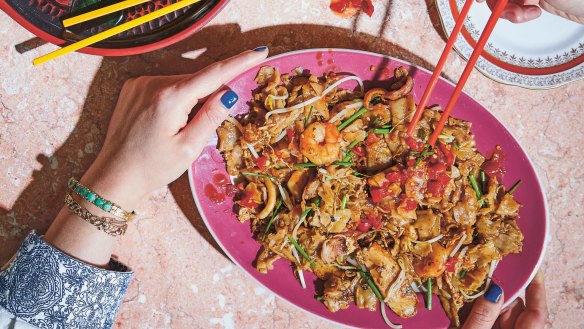
Quizzed by strangers about her background, Rosheen Kaul, who heads the kitchen at Melbourne's Etta restaurant, usually tells them she's Chinese-ish. It's a shorthand way of acknowledging her far spicier heritage, which includes Chinese, Filipino, Kashmiri, Malay, Peranakan and Indonesian influences.
The Singapore-born chef has teamed up with illustrator (and former waiter) Joanna Hu, who hails from China's Hunan province. Together, they've produced Chinese-ish, a cookbook pooling all the Chinese-inspired recipes that have come into their lives, which they describe as not quite authentic but 100 per cent delicious. Amen to that.
Char kway teow (pictured above)
Smoky, slippery, fatty and rich, these hawker-style noodles are laced with soft clouds of egg. This recipe is for one serve only, because you won't get the same charred flavour from an overcrowded pan. Multiply as required for more servings. If you're short on time, shop-bought sambal oelek is fine to use instead of the chilli paste.
INGREDIENTS
- ⅓ cup (80ml) melted lard (see Notes) or vegetable oil
- 2 cloves garlic, minced
- 125g fresh thick rice noodles
- 25g fresh thick egg noodles
- ½ Chinese sausage (see Notes), thinly sliced on the diagonal
- 4 slices fish cake (see Notes)
- 4 raw prawns, peeled and deveined
- 1 egg, lightly beaten
- 1 handful bean sprouts, trimmed at both ends
- 30g garlic chives, cut into thirds
Chilli paste
- 5 dried Sichuan chillies, soaked in water until soft, then drained
- 2 fresh red chillies
- 3 shallots
- 1 tsp vegetable oil
- pinch of salt
Sauce
- 1½ tsp dark soy sauce
- ½ tsp kecap manis
- 1 tsp fish sauce
- 1 tbsp light soy sauce
METHOD
- To make the chilli paste, blitz all of the ingredients together in a food processor to form a fine paste and set aside. You will need 1 tablespoon of this chilli paste (or sambal oelek, if using) for each portion of noodles. Store the remaining chilli paste in an airtight container in the fridge for up to a week.
- To make the sauce, whisk all of the ingredients together in a small bowl and set aside.
- Heat the lard or oil in a wok or frying pan over high heat until smoking. Add the garlic and fry until fragrant, 10-15 seconds, then add the rice noodles and egg noodles. Stir-fry over high heat for around 30 seconds, then add the Chinese sausage, fish cake and prawns. Continue to stir-fry over high heat until the sausage fat begins to render and the noodles are lightly charred, 2-3 minutes.
- Add the sauce and 1 tablespoon of the chilli paste or sambal oelek (use more if you want more heat) and toss to coat.
- Push the noodles to the side of the pan and add the beaten egg, bean sprouts and garlic chives. Fry for 30-40 seconds over high heat, until the chives begin to wilt.
- Mix everything together, then transfer to a plate and serve immediately.
Serves 1
Note: Lard is a flavoursome fat used in traditional Chinese cooking. You can buy it at most supermarkets and butchers. Chinese sausage and fish cake are found in the fridge section of well-stocked Asian grocers.
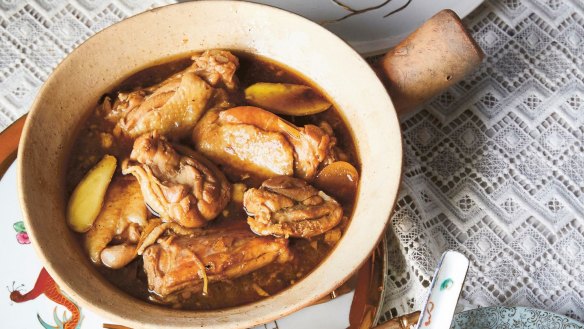
Mum's braised ginger chicken
If any dish were to taste like home to me, this would be it. Fragrant with toasted sesame oil, a little soy and plenty of warming ginger, this simple, comforting braise makes an appearance on our dinner table any time someone shows signs of illness. Served simply with steamed rice, it literally tastes like a warm hug from my mum.
INGREDIENTS
- ¼ cup (60ml) sesame oil
- 6cm piece old ginger (see Note), skin on, sliced
- 6-8 chicken thigh fillets, cut in half
- 1 tsp salt
- 1 tsp caster sugar
- 1 tsp light soy sauce
- 1 tbsp Shaoxing wine
- steamed rice, to serve
METHOD
- Heat the sesame oil in a wok or a frying pan over medium heat, add the ginger and stir-fry until fragrant. Add the chicken pieces and stir-fry until they start to brown, 4-5 minutes.
- Add the salt, sugar, 2½ tablespoons water and soy sauce and stir. Cover and allow to simmer for 7-8 minutes. Pour the Shaoxing wine over the top and simmer briefly, until the chicken is cooked through. Serve hot with steamed rice.
Serves 4
Note: Old ginger is spicier than regular young ginger and has a fibrous, dry texture. Find it at most Asian grocers. If you can't source any, use regular ginger instead.
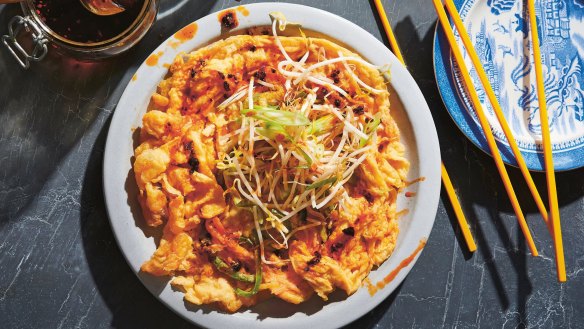
Chiffon omelette
They say the key to a perfect omelette is the right technique and a lot of patience. If we're talking about the French omelette, that is absolutely right. By this definition, a perfect omelette has a pale and even yellow colour, with no signs of caramelisation. While the surface of the omelette is perfectly set, the centre is just underdone, giving way to a custardy interior when sliced open. Perfection, as they say.
The masala omelettes, fried oyster omelettes and green bean omelettes of my childhood all beg to differ. Crisp, fluffy and golden – a result of plenty of oil and plenty of heat – the Asian approach to omelettes champions all of the characteristics the Western world condemns.
This omelette recipe is a hybrid of the Thai khai jiao and egg foo young. Eggs are whisked thoroughly, combined with fillings of your choice and fried in hot oil to create golden clouds. You can introduce as many or as few fillings as you like – just ensure that they are sliced thinly enough to cook quickly, or are already cooked. I have written as many suggestions for fillings as I can think of, but feel free to improvise. I particularly like the version with crab and spring onion.
INGREDIENTS
- 4 eggs
- 1 tsp salt
- ¼ tsp ground white pepper
- 1 tbsp cornflour blended with 1 tbsp water
- 2 spring onions, white part cut into 3cm lengths, green part thinly sliced
- 50g shredded char siu pork, ham or cooked chicken
- 50g cooked crab meat or cooked prawns
- 50-60g julienned fresh shiitake mushrooms, bamboo shoots, carrots, bean sprouts or brown onion
- 1 cup (250ml) vegetable oil
- steamed rice, to serve
METHOD
- Whisk the eggs, salt, white pepper and cornflour slurry together thoroughly. Ensure there are no strands of egg white remaining and that the mixture is well combined. Add the white spring onion, cooked meat and seafood, and the julienned vegetables, then stir to combine with the egg mixture. Set aside.
- Heat the vegetable oil in a wok or frying pan until smoking and pour the egg mixture in. It will puff up as soon as it hits the hot oil.
- Allow the omelette to cook for 10 seconds, then tilt the pan to allow the egg mixture to run from the centre of the omelette into the oil. Repeat the process until the omelette is fluffy, evenly cooked and beginning to crisp around the edges. It should resemble a soft yellow cloud. Lift the omelette gently with your spatula and flip it. Cook for 10 seconds on the other side.
- Remove the omelette from the wok and drain on paper towel to absorb the excess oil. Serve with sliced green spring onion and steamed rice.
Makes 1 to share between 2
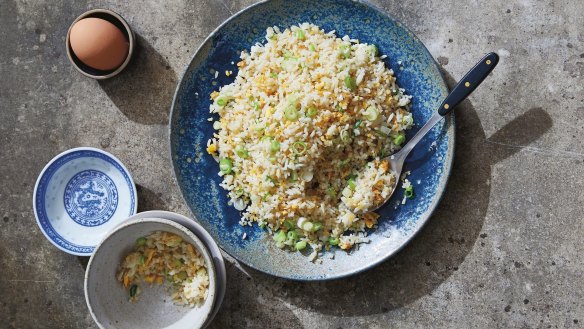
Egg fried rice
Needing no introduction, Egg fried rice is the most basic fried rice in the Chinese repertoire. Consider it a jumping-off point for other variations and a base for adding any other ingredients you wish. Once you can successfully cook egg fried rice, you'll be able to nail every other version, too.
INGREDIENTS
- 2 ⅔ cups (500g) day-old cooked rice
- ¼ cup (60ml) vegetable oil
- 2 eggs
- ¼ tsp ground white pepper
- 2 tsp salt
- 1 tsp caster sugar
- 1 tsp MSG (optional, see Note)
- 2 spring onions, sliced into rounds
METHOD
- Very gently break up any lumps of rice with a spatula or your fingers, taking care to keep the individual grains intact. Allow the rice to come to room temperature.
- Heat the vegetable oil in a wok or frying pan over medium heat. When the oil is hot, add the eggs and stir quickly. Make a well in the centre of the partially cooked eggs and add the rice. Stir the rice through the eggs, continuing to break up any lumps you find. You want to distribute the egg through the rice as evenly as possible.
- Continue to cook the rice over medium-high heat until the grains fluff up again from the steam. The key is to control the heat – don't let the grains burn or colour in any way. Be patient.
- When the rice is ready and starting to sizzle, add the white pepper, salt, sugar and MSG (if using) and stir through. Add the spring onion and cook for 1 minute or so before serving.
Serves 4
Note: MSG is a flavour enhancer used in East Asian cooking to intensify savouriness, and provide body and balance to some dishes. It is naturally occurring in some cheeses, seaweed and tomatoes. You can find it at most Asian grocers.
Smashed cucumber salad
It's not often you come across a dish that is as much fun to prepare as it is to eat. Smacking the cucumber with the back of a knife or cleaver, or even a hammer, creates lovely nooks and crevices for the dressing to find its way into, resulting in a punchy, refreshing dish for those swelteringly hot days.
INGREDIENTS
- 1 Lebanese cucumber
- ½ tsp salt
- coriander leaves, to serve
Dressing
- 1 tbsp light soy sauce
- 1 tbsp sesame oil
- 1 tbsp chilli oil (see below, or use Lao Gan Mao chilli oil)
- 1 tbsp Chinkiang black vinegar
- 3 cloves garlic, grated
- 1 tsp caster sugar
METHOD
- Top and tail the cucumber and halve it lengthways. Use the blunt edge of a knife or cleaver to smash it into bite-size pieces. Sprinkle with the salt and allow to stand for 10 minutes to draw out the excess moisture. Rinse off the salt and drain the cucumber in a colander, then pat it dry with paper towel.
- To make the dressing, mix all the ingredients to combine. Toss the cucumber through the dressing to coat, top with coriander leaves and serve.
Serves 1
Note: If chilli oil isn't your thing, you can make a milder version of this salad. Heat 1 tablespoon vegetable oil until smoking and pour it over the salad instead of the chilli oil, along with the dressing. The flavour of cooked oil is a common and welcome addition to fresh garnishes and condiments in Chinese cuisine.
Chilli oil
The common Chinese name for chilli oil – hong you, or "red oil" – is a reference to its astonishingly vibrant colour. In its purest form chilli oil is made by pouring hot oil over crushed dried chillies and leaving them to infuse. I like mine with heaps of salty sediment, and this recipe ensures the maximum amount of "bits" at the bottom of the jar. I've divided the recipe into parts for clarity. Dried Sichuan chillies are long, red, intensely flavoured chillies. There are a few varieties available, ranging from moderate to very spicy, and your local Asian grocer should stock at least one of them. If you can't get them, use any other dried chillies, but remember the heat will vary.
INGREDIENTS
Part 1
- 40g dried Sichuan chillies, or other dried chillies
- 2 tbsp vegetable oil
- 1 tsp Sichuan peppercorns
Part 2
- 10 fresh red chillies, topped
- 3 cloves garlic, peeled
- 3cm piece ginger, peeled
- ¼ cup (60ml) vegetable oil
- 2 tsp salt
- 2 tsp caster sugar
Part 3
- 1 spring onion, white part only
- 1½ cups (375ml) vegetable oil
- 3cm piece ginger, skin on, sliced
- 2 star anise
- 1 black cardamom pod
METHOD
- To make part 1, use a pair of sharp kitchen scissors to cut the dried chillies into small pieces. Heat the oil in a wok or frying pan and fry the chillies and peppercorns over low heat until they are fragrant and the chillies have turned a deep red. Keep moving the chillies and be extremely careful not to burn them. Allow to cool, then crush using a mortar and pestle. Transfer to a bowl.
- To make part 2, place the fresh chillies, garlic and ginger in a food processor and blitz to combine. Warm the oil in a small saucepan and add the chilli mixture. Fry over low heat until the moisture evaporates, 5-6 minutes. Allow to cool, then stir through the salt and sugar. Combine this mixture with the dried chilli mixture in a heatproof bowl and set aside.
- To make part 3, cut the white spring onion into large pieces. Don't cut the pieces too small, or they will cook too quickly and burn.
- Pour the oil into a large saucepan that can hold double its volume (as the oil will bubble up) and place over medium heat. Add the spring onion and ginger and fry until golden, then remove from the oil and discard.
- Add the star anise and cardamom to the oil and fry over low heat until fragrant. At this point, the oil should be very hot. Pour half the oil over the chilli mixture and stir. Wait 5-6 minutes for the oil to cool slightly, then pour the remaining oil over the chilli mixture.
- Once the chilli oil is completely cooled, remove the star anise and cardamom and discard. Cover the oil and leave overnight at room temperature.
- The next day, the oil should have turned a dark red colour. Pour into a sterilised airtight container or jar and store in a cool dark place for up to 3 months. Try this chilli oil on avocado and feta toast, on pasta, or mixed with Chinkiang black vinegar and soy sauce for a classic dumpling dipping sauce.
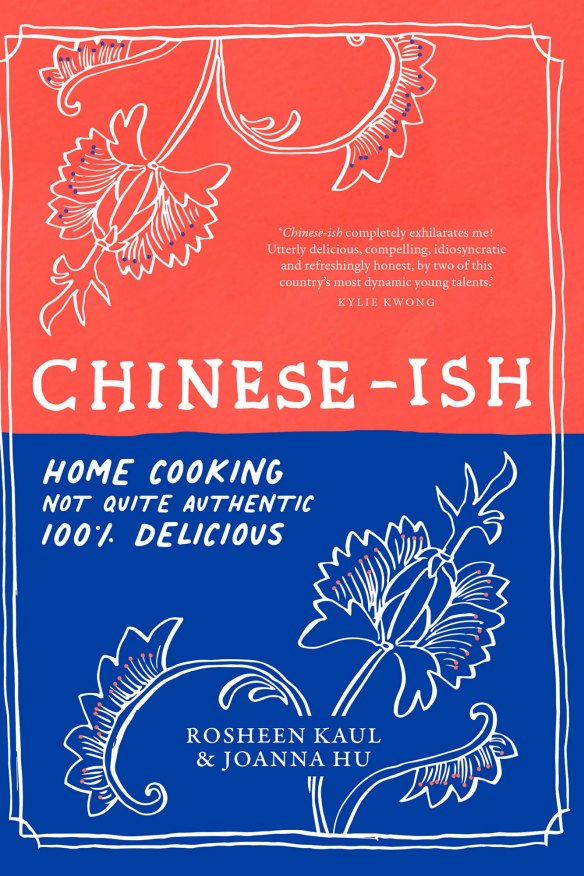
Makes 1½ cups (375ml)
This is an edited extract from Chinese-ish by Rosheen Kaul and Joanna Hu, photography by Armelle Habib. Murdoch Books RRP $39.99. Buy now
